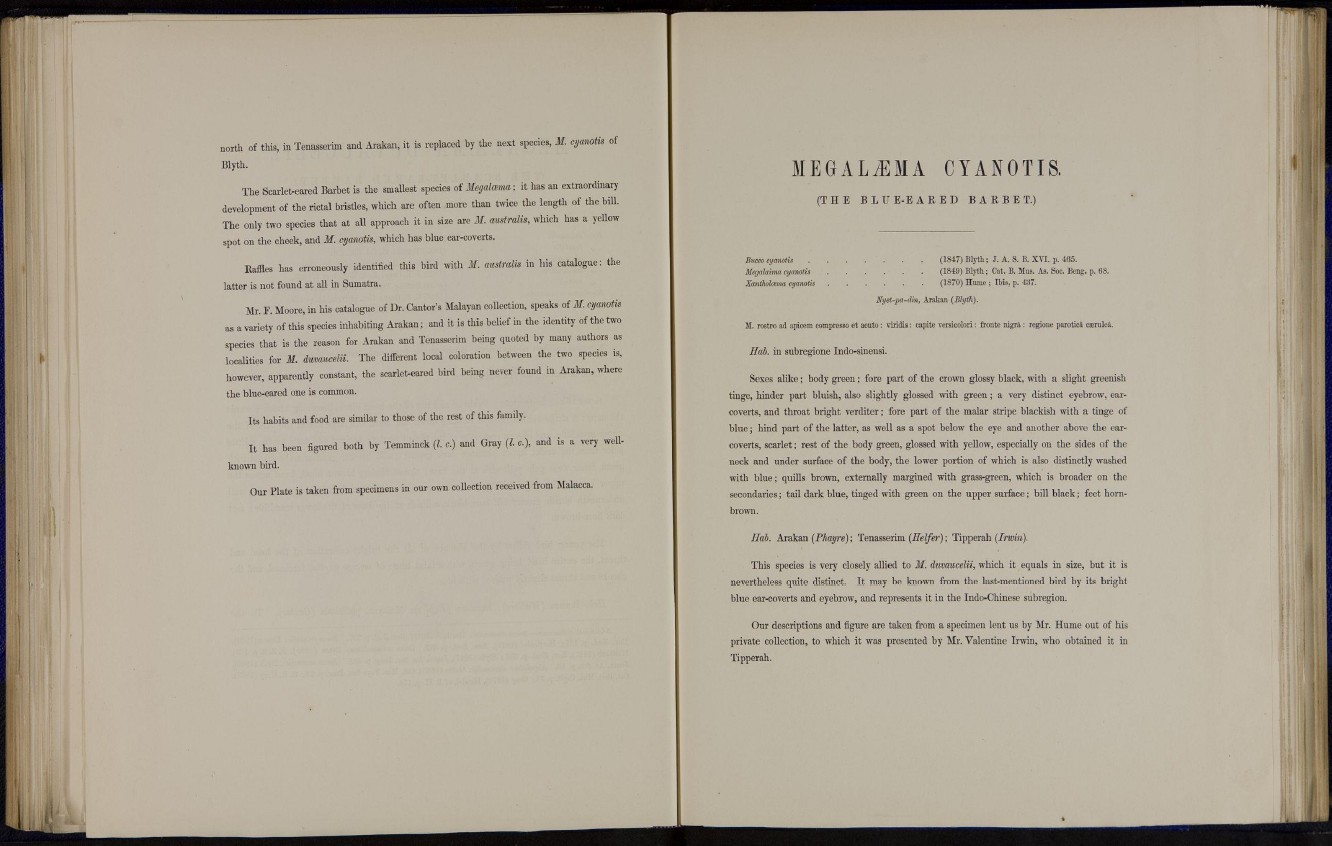
north of this, in Tenasserim and Arakan, i t is replaced by the next species, M. cyanotis of
Blyth.
The Scarlet-eared Barbet is t h e smallest species of Megalatma; it has a n extraordinary
development of the rictal bristles, which are often more than twice the length of the bill.
The only two species that at all approach it in size are M. australis, which has a yellow
spot on the cheek, and M. cyanotis, which has blue ear-coverts.
Raffles has erroneously identified this bird with M. australis in his catalogue: the
l a t t e r is not found at all in Sumatra.
Mr. F . Moore, in his catalogue of Dr. Cantor's Malayan collection, speaks of M. cyanotis
as a variety of this species inhabiting Arakan; and it is this belief in the identity of the two
species that is the reason for Arakan and Tenasserim being quoted by many authors as
localities for M. duvauce/ii. The different local coloration between the two species is,
however, apparently constant, the scarlet-eared bird being never found in Arakan, where
the blue-eared one is common.
I t s habits and food are similar to those of the rest of this family.
I t has been figured both by Temminck (I. c.) and Gray (/. c), and is a very wellknown
bird.
Our Plate is taken from specimens in our own collection received from Malacca.
M E G A L iE M A CYANOTIS.
( T H E B L U E - E A R E D B A R B E T .)
Bucco cyanotis (1847) Blyth; J. A. S. B. XVI. p. 465.
Megalaima cyanotis (1849) Blyth; Cat. B. Mus. As. Soc. Beng. p. 6S.
Xanthohema cyanotis (1870) Hume ; Ibis, p. 437.
Nyet-pa-din, Arakan (Blyth).
11. rostro ad apicem compresso et acute : viridis: eapite versicolori: fronte nigra : regione parotica cserulea.
Hab. in s u b r e g i o n e Indo-sinensi.
S e x e s a l i k e ; body g r e e n ; fore part of t h e crown glossy black, w i t h a slight greenish
t i n g e , h i n d e r part bluish, a l s o s l i g h t l y glossed with g r e e n ; a very distinct eyebrow, earc
o v e r t s , and throat b r i g h t v e r d i t e r ; fore part of t h e malar stripe b l a c k i s h w i t h a t i n g e of
b l u e ; h i n d part of t h e l a t t e r , as w e l l as a spot b e l o w t h e eye and a n o t h e r above t h e earc
o v e r t s , s c a r l e t ; rest of t h e body green, g l o s s e d w i t h y e l l o w , e s p e c i a l l y on t h e sides of the
n e c k and under surface of t h e body, t h e lower portion of w h i c h is also d i s t i n c t l y washed
w i t h b l u e ; quills brown, e x t e r n a l l y margined w i t h grass-green, w h i c h is broader on the
s e c o n d a r i e s ; tail dark b l u e , t i n g e d w i t h g r e e n on t h e upper s u r f a c e ; bill b l a c k ; feet hornbrown.
Hab. Arakan (Phayre); Tenasserim (Heifer); Tipperah (Irwin).
T h i s species is very c l o s e l y a l l i e d to M. duvaucelii, which it equals in size, b u t it is
n e v e r t h e l e s s quite distinct. It may be k n o w n from t h e l a s t - m e n t i o n e d bird b y its bright
b l u e ear-coverts and eyebrow, and represents i t i n t h e I n d o - C h i n e s e subregion.
Our descriptions and figure are taken from a specimen lent us by Mr. Hume out of his
private collection, to which it was presented by Mr. Valentine Irwin, who obtained it in
Tipperah.